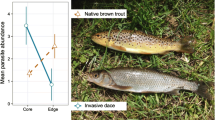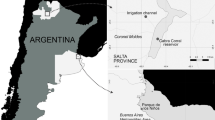Abstract
The dynamics of the emergence, duration, and decline phases in epizootic cycles are well known for humans and some crops, but they are poorly understood for host–parasite systems in the wild. Parasites may be particularly insidious as they are often introduced unintentionally, simultaneously with their hosts, and later transferred to species in the new location. Here we investigate the epizootic dynamics of the tapeworm Ligula intestinalis in the Hamiz reservoir, Algeria, and explore its effects on the cyprinid fish Barbus callensis. Regular sampling was conducted from October 2005 to February 2008 with intermittent surveys carried out until 2010. Five percent of the 566 specimens of B. callensis that were caught were infected, with the maximum number of parasites found in spring. There was no obvious difference in weight between uninfected fish and infected ones, and infection did not affect fish condition. However, infected fish were significantly longer than uninfected fish and had inhibited gonad development. The proportion of infected fish caught was significantly higher in year 1 and by the second winter, infection collapsed to zero. The Ligula infection thus appeared to have minimal ecological effects and be of a temporary nature, thus exhibiting an epizootic cycle. Taken together, our data indicates that this infection declined or even failed during our study period. Failure may be due to the specific genetic strain of Ligula, but invasive carp may also have been influential in both the introduction and subsequent decline of this parasite.
Similar content being viewed by others
References
Avibase 2014. The World Bird Database (24 June 2003) https://doi.org/avibase.bsc-eoc.org
Barber I., Daniel Hoare D., Krause J. 2000. Effects of parasites on fish behaviour: a review and evolutionary perspective. Reviews in Fish Biology and Fisheries, 10, 131–165
Barson M., Marshall B.E. 2003. The occurrence of the tapeworm, Ligula intestinalis (L.), in Barbus paludinosus from a small dam in Zimbabwe. African Journal of Aquatic Science, 28, 75–78
Bouzid-Lamine W. 2008. Genetic structure of Ligula intestinalis (Cestoda: Diphyllobothriidea), a parasite of freshwater fish. PhD Thesis, University of Toulouse III — Paul Sabatier, France, pp. 162. (In French)
Bouzid W., Štefka J., Bahri-Sfar L., Peter Beerli P., Loot G., Lek S., Haddaoui N., Hypša V., Tomáš Scholz T., Dkhil-Abbes T., Meddour R., Ben Hassine O.K. 2013. Pathways of cryptic invasion in a fish parasite traced using coalescent analysis and epidemiological survey. Biological Invasions, 15, 1907–1923. DOI: 10.1007/s10530-013-0418-y
Bouzid W., Stefka J., Hypsa V., Lek S., Scholz T., Legal L., Ben Hassine O.K., Loot G. 2008. Geography and host specificity: Two forces behind the genetic structure of the freshwater fish parasite Ligula intestinalis (Cestoda: Diphyllobothriidae). International Journal for Parasitology, 38 (12), 1465–1479. DOI: 10.1016/j.ijpara.2008.03.008
Britton J.R., Pegg J. 2011. Ecology of European Barbel Barbus Barbus: Implications for River, Fishery, and Conservation Management. Reviews in Fisheries Science, 19, 321–330. DOI: 10.1080/10641262.2011.599886
Britton J.R., Jackson M.C., Harper D.M. 2009. Ligula intestinalis (Cestoda: Diphyllobothriidae) in Kenya: a field investigation into host specificity and behavioural alterations. Parasitology, 136, 1367–1373. DOI: 10.1017/S003118200999059X
Bush A.O., Lafferty K.D., Lotz J.M., Shostak A.W. 1997. Parasitology meets Ecology on its own Terms: Margolis et al. Revised. Journal of Parasitology, 83, 575–583. DOI: 10.2307/3284227
Carter V., Pierce R., Dufour S., Arme C., Hoole D. 2005. The tapeworm Ligula intestinalis (Cestoda: Pseudophyllidea) inhibits LH expression and puberty in its teleost host, Rutilus rutilus. Society for Reproduction and Fertility, 130, 939–945. DOI:10.1530/rep.1.00742
Cherghou S., Khodari M., Yaâkoubi F., Benadid M., Badri A. 2002. Contribution to the study of the diet of barbel, Barbus barbus callensis (Valenciennes, 1842) of a stream of the Middle Atlas (Morocco): wadi Boufekrane. Revue des sciences de l’eau, 15, 153–163. (In French)
Crivelli A.J. 1992. Are introduced species the right answer to the declining inland fisheries within the Mediterranean region? World Fisheries Congress, Abstract Bulletin, 143
Dejen E., Vijverberg J., Sibbing F.A. 2006. Spatial and temporal variation of cestode infection and its effects on two small barbs (Barbus humilis and B. tanapelagius) in Lake Tana, Ethiopia. Hydrobiologia, 556, 109–117. DOI: 10.1007/s10750-005-1187-0
Dubinina M.N. 1980. Tapeworms, (Cestoda, Ligulidae) of the Fauna of the U.S.S.R. US Department of Commerce National Technical Information Service Springfield, USA, pp. vii + 320
Dumont H.J. 1979. Limnologie van Sahara en Sahel. D Sci Thesis, University of Ghent, Belgium, pp. 557
Dunn A.M., Torchin M.E., Hatcher M.J., Kotanen P.M., Blumenthal D.M., Byers J.E., Coon Courtney A.C., Frankel V.M., Holt R.D., Hufbauer R.A., Kanarek A.R., Schierenbeck K.A., Wolfe L.M., Perkins S.E. 2012. Indirect effects of parasites in invasions. Functional Ecology, 26, 1262–1274. DOI:10.1111/j.1365-2435.2012.02041.x
Dussart B. 1967. Copepods inland waters of Western Europe. I: calanoid and harpacticoid]. N. Boubée et Cie (eds.), Paris, pp. 1–500 (In French)
Dussart B. 1969. Copepods inland waters of Western Europe. II: Cyclopoids and biology. N. Boubée et Cie (eds.), Paris, 1–292 pp. (In French)
Ergonul M.B., Altindag A. 2005. The effects of Ligula intestinalis plerocercoids on the growth features of Tench, Tinca tinca. Turkish Journal of Veterinary and Animal Sciences, 29, 1337–1341
Froese R., Pauly D. 2014. Fishbase. World Wide Web electronic publication. (version 06/2014). https://doi.org/www.fishbase.org
García N., Cuttelod A., Abdul Malak D. (ed) 2010. The Status and Distribution of Freshwater Biodiversity in Northern Africa. Gland, Switzerland, Cambridge, UK, and Malaga, Spain: IUCN ISBN: 978-2-8317-1271-0, pp. 141
Georgiev B.B., Angelov A., Vasileva G.P., Sánchez M.I., Hortas F., Mutafchiev Y., Pankov P., Green A.J. 2014. Larval helminths in the invasive American brine shrimp Artemia franciscana throughout its annual cycle. Acta Parasitologica, 59, 000–000. DOI: 10.2478/s11686-014-0255-x
Heins D.C., Baker J.A., Green D.M. 2011. Processes influencing the duration and decline of epizootics in Schistocephalus solidus. Journal of Parasitology 97, 371–376. DOI: 10.1645/GE-2699.1
Hoole D., Carter V., Dufour S. 2010. Ligula intestinalis (Cestoda: Pseudophyllidea): an ideal fish-metazoan parasite model? Parasitology, 137, 425–438. DOI:10.1017/S0031182010000107
IUCN 2014. The IUCN Red List of Threatened Species. Version 3.2014. https://doi.org/www.iucnredlist.org
Jobling S., Tyler C.R. 2003. Endocrine disruption, parasites and pollutants in wild freshwater fish. Parasitology, 126, S103–S107 DOI: 10.1017/S0031182003003652
Kennedy C.R. 1993. Introductions, spread and colonization of new localities by fish helminth and crustacean parasites in the British Isles: A perspective ans appraisal. Journal of Fish Biology, 43, 287–301
Kennedy C.R., Burrough R.J. 1981. The establishment and subsequent history of a population of Ligula intestinalis in roach Rutilus rutilus (L.), Journal of Fish Biology, 19, 105–126. DOI: 10.1111/j.1095-8649.1981.tb05815.x
Kennedy C.R., Shears P.C., Shears J.A. 2001. Long-term dynamics of Ligula intestinalis and roach Rutilus rutilus: a study of three epizootic cycles over thirty-one years. Parasitology, 123, 257–269. DOI: 10.1017/S0031182001008538
Korkmaz A.S., Zencir O. 2009. Annual dynamics of tapeworm, Ligula intestinalis parasitism in Tench (Tinca tinca) from Beysehir Lake, Turkey. Journal of Animal and Veterinary Advances, 8, 1790–1793
Kraïem M.M. 1994. Systematics, biogeography and bio- ecology of Barbus callensis Valenciennes, 1842 (fish, Cyprinidae) in Tunisia. PhD Thesis, Biol. Fac. Sci., Tunisia, pp. 227 (In French)
Kraïem M.M. 1996. The diet of Barbus callensis (Cyprinidae) in Northern Tunisia. Cybium, 20, 75–85
Kroupova H., Trubiroha A., Wuertz S., Frank S.N., Sures B., Kloas W. 2012. Nutritional status and gene expression along the somatotropic axis in roach (Rutilus rutilus) infected with the tapeworm Ligula intestinalis. General and Comparative Endocrinology, 177, 270–277. DOI: 10.1016/j.ygcen.2012. 04.007
Lafferty K.D., Torchin M.E., Kuris A.M. 2010. The geography of host and parasite invasions Pages 191–202 in S. Morand and B. Krasnow, eds. The Geography of Host-Parasite Interactions. Oxford University Press, Oxford, U.K.
Lévêque C., Daget J. 1984. Cyprinidae. In: CLOFFA 1: Check List of the Freshwater Fishes of Africa (Dajet J., Gosse J.P. & Thys van den Audenaerde D.F.E.), Orstom & Tervuren: MRAC (eds.), Paris, pp. 410
Loot G., Francisco P., Santoul F., Lek S., Guegan J.F. 2001. The three hosts of the Ligula intestinalis (Cestoda) life cycle in Lavernose-Lacasse gravel pit, France. Archiv fur Hydrobiologie, 152, 511–525
Loot G., Aulagnier S., Lek S., Thomas F., Guegan J.F. 2002. Experimental demonstration of a behavioural modification in a cyprinid fish, Rutilus rutilus (L.), induced by a parasite, Ligula intestinalis (L.). Canadian Journal of Zoology, 80, 738–744
Margolis L., Esch G.W., Holmes J.C., Kuris A.M., Schad G.A. 1982. The use of ecological terms in parasitology (report of an ad hoc committee of the American Society of Parasitologists). Journal of Parasitology, 68, 131–133
Msafiri A., Kwendwa K., Nestory P.G., Alistidia M. 2014. Assessment of the effects of plerocercoid larvae of Ligula intestinalis (Cestoda) on Engraulicypris sardella (Cyprinidae) from northern Lake Nyasa/Malawi/Niasa. Aquatic Ecosystem Health & Management, 17, 90–96. DOI: 10.1080/14634988.2014.875444A
Nash R.D.M., Valencia A.H., Geffen A.J. 2006. The origin of Fulton’s condition factor- setting the record straight. Fisheries, 31, 236–238
Ould Rouis S., Ould Rouis A., Micha J.C., Arab A. 2012. Reproductive biology of the Cyprinidae, Barbus callensis in an Algerian Dam. Tropicultura, 30, 88–93. (In French)
Parsa Khanghah A., Mojazi Amiri B., Sharifpour I., Jalali jafari B., Motalebi A.A. 2011. Gonad tissue changes of Chalcalburnus mossulensis (Heckel, 1843) infected by Ligula intestinalis (cestoda). Iranian Journal of Fisheries Sciences, 10, 85–94
Piasecki W., Goodwin A.E., Eiras J.C., Nowak B.F. 2004. Importance of Copepoda in freshwater aquaculture. Zoological Studies, 43, 193–205
Pyšek P., Richardson D.M. 2010. Invasive Species, Environmental Change and Management, and Health. Annu. Rev. Environ. Resour., 35, 25–55. DOI: 10.1146/annurev-environ-033009-095548
Quinnell R.J., Grafen A., Woolhouse M.E.J. 1995. Changes in parasite aggregation with age: a discrete infection model. Parasitology, 111, 635–644
Reiczigel J., Rózsa L. 2005. Quantitative Parasitology 3.0. Budapest, Hungary. Distributed by the authors
Richardson D.M., Pyšek P., Rejmánek M., Barbour M.G., Dane Panetta F., West C.J. 2000. Naturalization and Invasion of Alien Plants: Concepts and Definitions. Diversity and Distributions, 6, 93–107
Samraoui B., Samraoui F. 2008. An ornithological survey of Algerian wetlands: Important bird areas, Ramsar sites and threatened species. Wildfowl, 58, 71–96
Samraoui F., Alfarhan A.H., Al-Rasheid K.A.S., Samraoui B. 2011. An appraisal of the status and distribution of waterbirds of Algeria: indicators of global changes? Ardeola, 58, 137–163
Simberloff D., Rejmánek M. 2010. Encyclopedia of Biological Invasions University of California Press, pp. 792
Simberloff D., Martin J.L., Genovesi P., Maris V., Wardle D.A., Aronson J., Courchamp F., Galil B., Garcıà-Berthou E., Pascal M., Pyšek P., Sousa R., Tabacchi E., Vilà M. 2013. Impacts of biological invasions: what’s what and the way forward. Trends in Ecology & Evolution, Ce Press, 28, 58–66. DOI: 10.1016/j.tree.2012.07.013
Sitjà-Bobadilla A. 2008. Living off a fish: A trade-off between parasites and the immune system. Fish & Shellfish Immunology, 25, 358–372. DOI: 10.1016/j.fsi.2008.03.018
Sitjà-Bobadilla A. 2009. Can Myxosporean parasites compromise fish and amphibian reproduction? Proc. R. Soc. B., 276, 2861–2870. DOI: 10.1098/rspb.2009.0368
Trubiroha A., Kroupova H., Frank S.N., Sures B., Kloas W. 2010. Inhibition of gametogenesis by the cestode Ligula intestinalis in roach (Rutilus rutilus) is attenuated under laboratory conditions. Parasitology, 138, 648–659. DOI: 10.1017/S0031182010001514
Turgut E., Develi N., Yeşilayer N., Buhan E. 2011. Seasonal Occurrence of Ligula intestinalis infection in Cyprinids from Almus Dam Lake, Turkey. Kahramanmaras Sutcu Imam University Journal of Natural Sciences, 14, 9–11
Urdeş L., Hangan M. 2013. The Epidemiology of Ligula intestinalis (Phylum Platyhelminthes) within the Cyprinid Populations Inhabiting the Danubian Delta Area. Animal Science and Biotechnologies, 46, 273–276
Vulpe V. 2002. Parasitic invasions on fish stocks of N-E area from Moldavia. Revista Scientia Parasitologica, 3, 144–149
Yen Nhi T.T., Mohd Shazili N.A., Shaharom-Harrison F. 2013. Use of cestodes as indicator of heavy metal pollution. Experimental Parasitology, 133, 75–79. DOI: 10.1016/j.exppara.2012.10.014
Zhokhov A.E., Pugacheva M.N. 2012. Distribution and occurrence of Ligula intestinalis (L.) Plerocercoids (Cestoda, Ligulidae) in the fishes of Lake Tana, Ethiopia. Inland Water Biology, 5, 293–298. DOI: 10.1134/S1995082912020162
Author information
Authors and Affiliations
Corresponding author
Rights and permissions
About this article
Cite this article
Rouis, S.O., Rouis, A.O., Dumont, H.J. et al. Dynamics and effects of Ligula intestinalis (L.) infection in the native fish Barbus callensis Valenciennes, 1842 in Algeria. Acta Parasit. 61, 307–318 (2016). https://doi.org/10.1515/ap-2016-0041
Received:
Revised:
Accepted:
Published:
Issue Date:
DOI: https://doi.org/10.1515/ap-2016-0041




